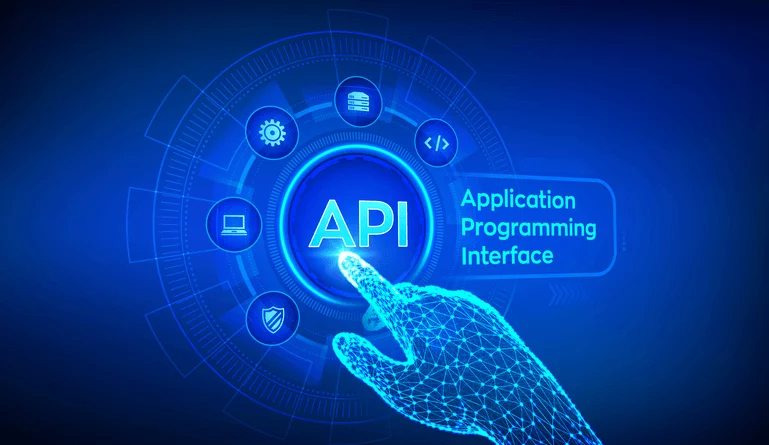The word Application Programming Interface must be resonating with you and you might have heard this terminology, particularly when it comes to the implementation of software systems in an organization. API, which is the acronym for Application Programming Interface, is a series of rules and protocols that helps applications fetch data and data points from other systems. An effective API will make the integration of two computer systems seamlessly talk to each other, as it will have all necessary building blocks put together by the computer programmer.
If we look at the below diagram, which is a basic information flow diagram depicting the position of an Application Programming Interface in the whole schema of system integration.
In simple APIs are also known as connectors that help establish a synchronized connection between two applications for the exchange of information on a real-time basis.
How does an API work?
Let us understand the working of an Application Programming Interface with a very simple example. We all are fond of watching movies in the cinema. When we plan to book a ticket, we go to the booking website, make our selection, enter credit card details, and voila, the tickets are ready, and we print it out.
However, what seems very simple on the front is a series of information exchanges between the website that you see on the front and the database at the back. How do you think this happens? Well, it is the Application Programming Interface that connects the website and the database, and this integration happens in real-time, which is why you feel an instant transaction, within seconds.
This was an example of a B2C (business to customer) transaction. However, the same is applicable in B2B transactions too. The only difference is that in this case, the request command comes from one business application, and then the information is fetched from another business system to complete the transaction.
What is pertinent is the fact that this data flow between two business applications has become the backbone of today’s enterprises. In the case of B2B integrations, APIs have a wider role to pray to transmit the data.
Why do we need API?
The importance of the Application Programming Interface is multifold. The role of API is to allow usage of data to the users in a faster, easier, and efficient way, for a specific purpose.
We have seen Application Programming Interface been used significantly in the private sector across enterprises, globally. However, it has been observed that governments are also now using APIs across their systems because it makes their applications agile and flexible.
While we agree that legacy systems have been operating in silos and today enterprises who want to transition from legacy systems to the latest cloud-based systems, APIs form an integral part of this whole framework.
Furthermore, organizations that are already on the path to digital transformation and have implemented different systems for different objectives, are looking to interconnect the applications so that the data is centrally available. This is another reason why APIs are needed as they will eventually help organizations to make informed decisions.
While companies do raise concerns on the security aspects of Application Programming Interface, but today programmers ensure that the building blocks of these APIs are strong. Moreover, APIs come with a series of permissions and audit trails to give that comfort to companies and governments, when it comes to the security of the application.
Technology is continuously evolving, and we are seeing new systems bringing about a paradigm shift in the way businesses manage their data. Application Programming Interface are going to play a key role in the new dimension to the way applications will operate.
(Also Read: Technology Stack – A Definitive Guide)
Examples of APIs
To help you understand what APIs do and how they operate, here are few examples that will help you get a deeper insight into APIs.
-
Weather Data
One common example of API that we see on a day-to-day basis is the data on weather. Our smartphones have this weather app that shares snippets on the weather.
-
Login Authentication
We see many websites and applications, which prompt users to log in using social media accounts such as Facebook, Twitter, LinkedIn, and Google.
-
Payment
When we order from e-commerce sites like Amazon, we get multiple options to make payments such as PayPal. Here the Amazon fetches information from the PayPal account and executes the payment.
-
Travel booking
On travel booking sites, we see that the site fetches information about flight schedules and hotel availabilities instantly. This happens through APIs where the booking portal interacts with the respective airline website or hotel website
These are just a few examples to give you an idea of the usability of APIs. However, there are many more examples in B2B and B2C space.
Types of APIs
There are many forms of Application Programming Interface. Software developers can use a variety of protocols and rules to build an API. Here we will look at some of the API types:
-
Web APIs
These are connectors that use the HTTP protocol. Web Application Programming Interface is used to interact with the browser, which will have web notifications and storage on the web. If we combine multiple Web APIs, then we can create a composite API, which is a collection of data or service Application Programming Interface.
-
Open APIs
These are also known as external APIs or public APIs. These Application Programming Interface are easily available to developers without any restrictions. Occasionally there might be some registration to be done to get an API key or it may be completely open.
-
Partner APIs
Technically these are similar to open Application Programming Interface, however, there is a restriction to access these. The access is usually controlled by a third-party API gateway.
-
Composite APIs
These are a combination of different Application Programming Interface that helps developers to access multiple data touchpoints in a single call. These touchpoints can be fetched through a single API or it can have multiple APIs fetching information from multiple data sources.
When it comes to successfully developing an Application Programming Interface, there are certain rules that developers need to follow. These are known as API protocols. One of the most common protocols that any developer follows is the REST API protocol.
REST known as Representational State Transfer is a very commonly used and popular Web Application Programming Interface framework. There are certain fundamentals around architecture and principles that developers need to adhere to.
The other type of Application Programming Interface protocol that is used by developers is the JSON-RPC and XML-RPC protocol. In both these protocols, an API call can contain multiple parameters.
Benefits of using APIs
For organizations, APIs are a way of developing applications that can deliver a better customer experience. Some of the key benefits of using APIs are as follows:
-
Easy to Integrate
APIs are connectors that help in connecting two applications and systems for data flow. This will ensure that the overall user experience is seamless.
-
Improved Integration
Having APIs with the right set of protocols helps in creating a better-integrated solution that can help organizations to manage their data and processes, thereby helping them gain better visibility.
-
Automation
While applications are being integrated using APIs, it automates various business processes and the tasks associated with them. This helps in bringing about great efficiency among various functions.
-
Enhanced Services
Having APIs makes the implementation of multiple systems very easy. These help in the case of systems, involving third-party applications as well.
-
Innovation
APIs play a critical role in the whole process of digital transformation for any organization. They help in developing unique business models by harnessing the power of technology.
Final Thoughts
To summarize, APIs can help software to deliver a good brand presence, by combining with third-party products or services. A good API with the right set of protocols can strengthen the technology architecture of the organization, making it the backbone of the entire enterprise.







